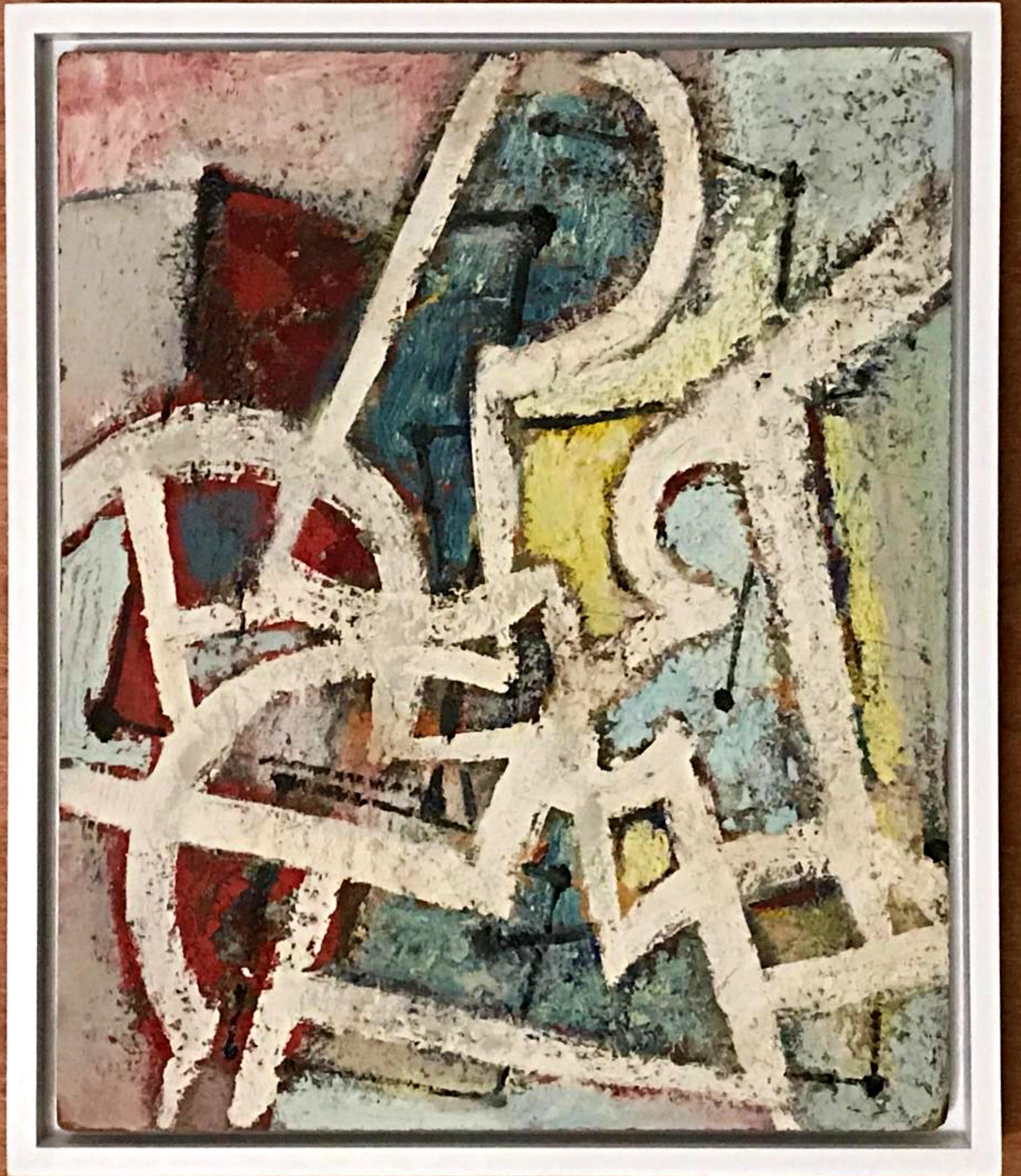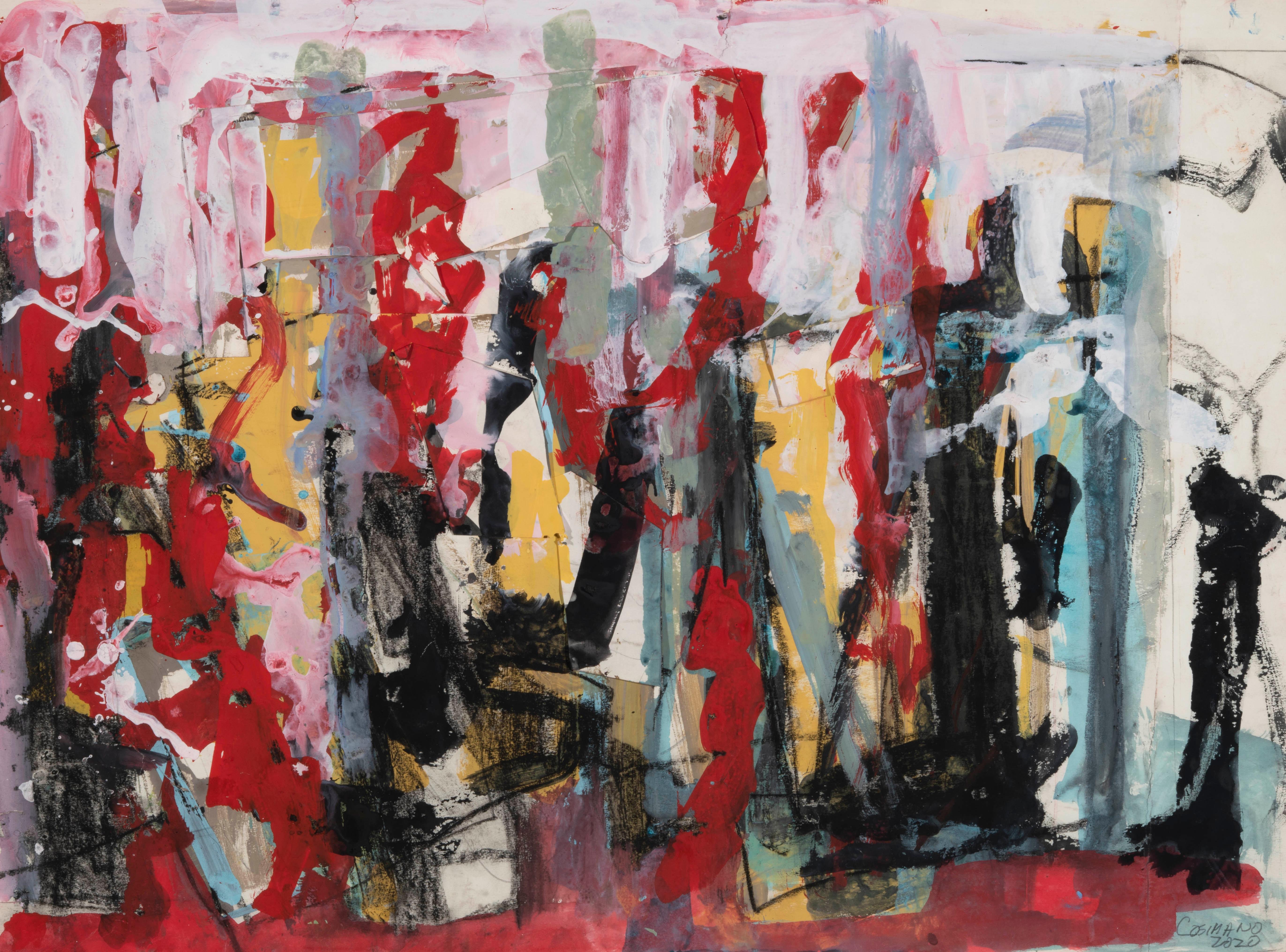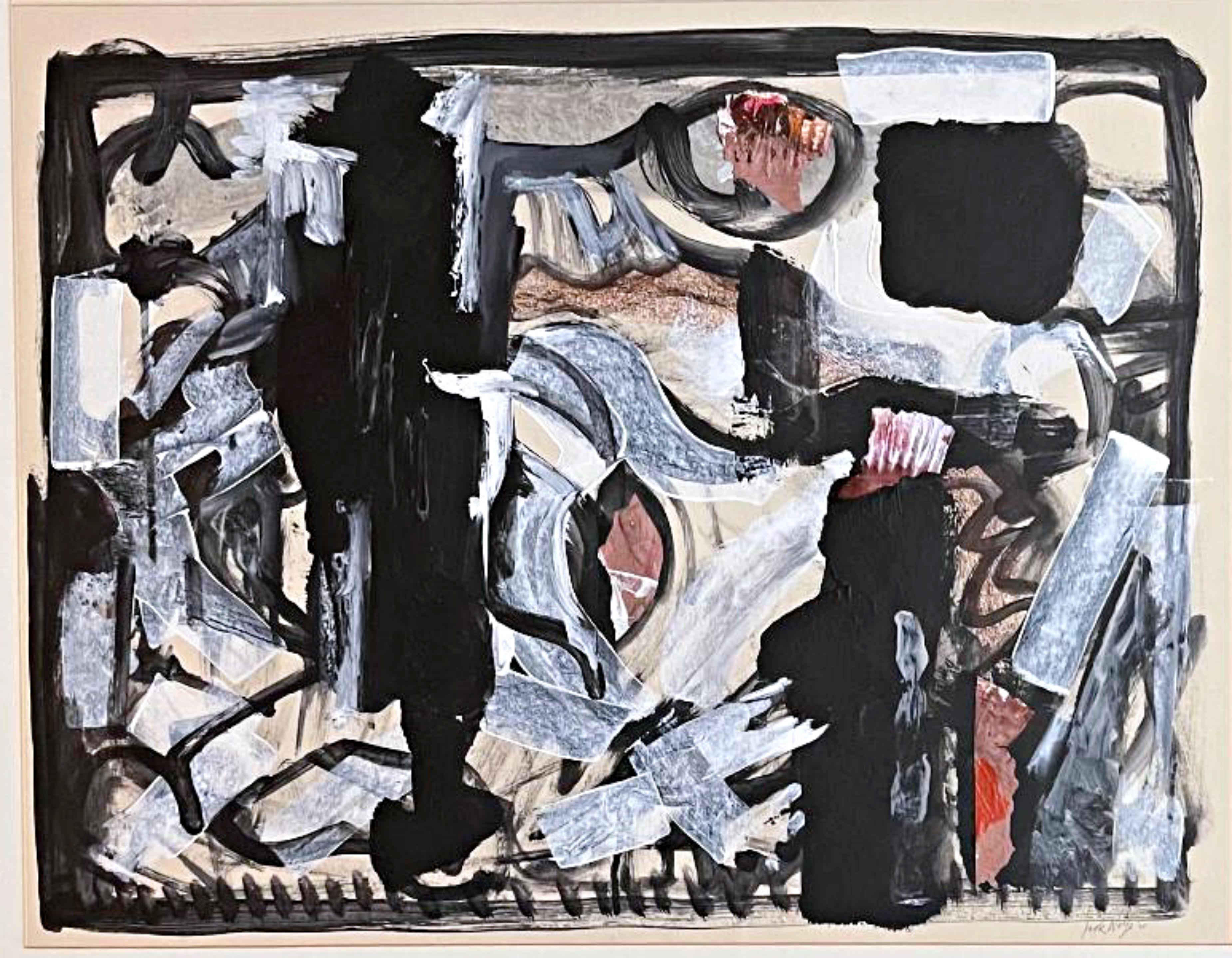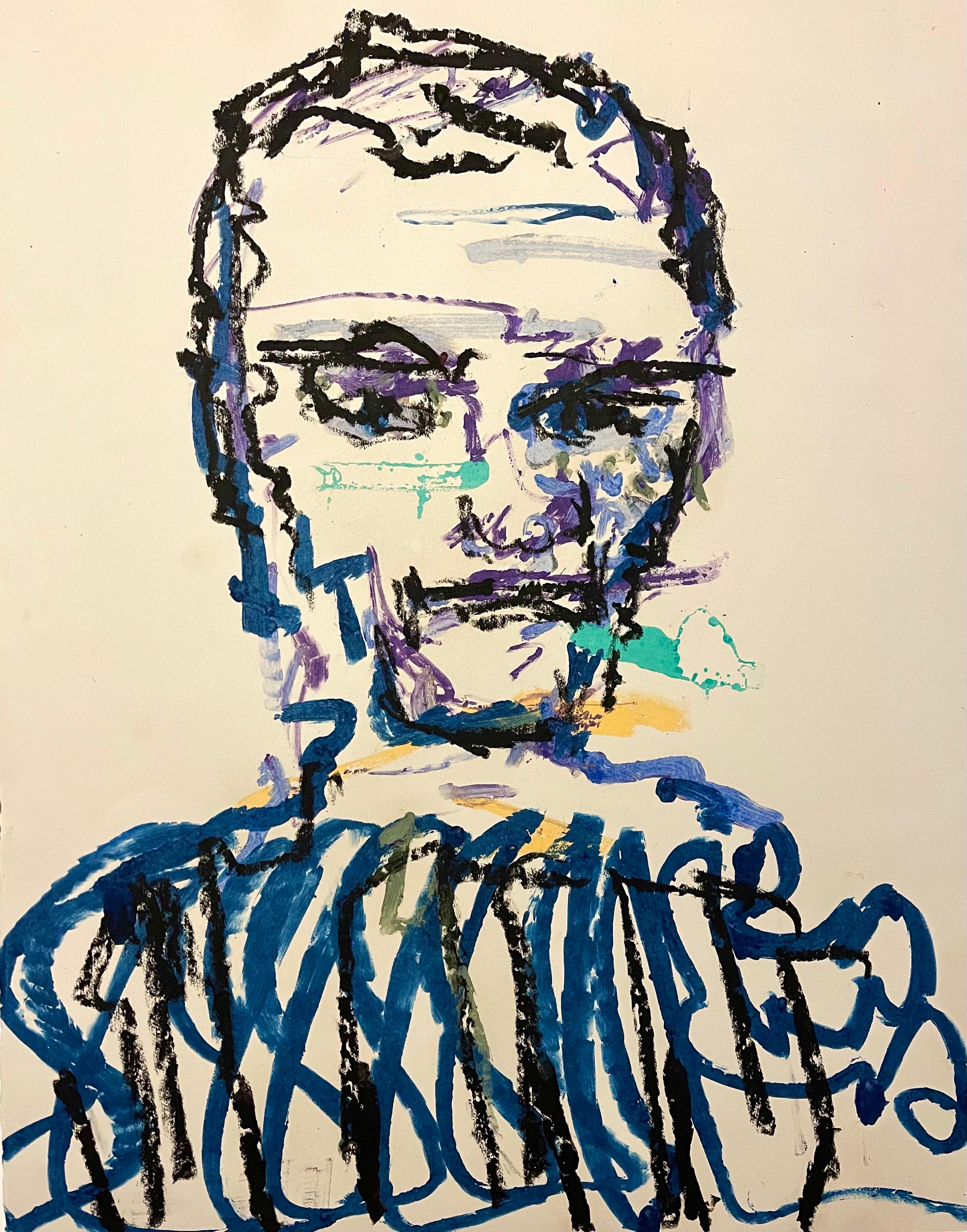Items Similar to 'Large Abstract', San Francisco Bay Area, North Beach, Beat, Beatnik, Big Sur
Want more images or videos?
Request additional images or videos from the seller
1 of 12
Keith Sanzenbach'Large Abstract', San Francisco Bay Area, North Beach, Beat, Beatnik, Big Sur 1956
1956
About the Item
Signed lower right, 'K. Sanzenbach' for Keith Sanzenbach (American, 1931-1964) and dated 1956. Additionally signed, verso, and with the artist's Lagunitas, California address.
The influential Bay Area critic, Thomas Albright, in his monumental history, 'Art in the San Francisco Bay Area, 1945-1980', commented that Keith Sanzenbach "..made some of the era's most interesting paintings". Peter Plagens, in 'Sunshine Muse, Contemporary Art on the West Coast', deemed him to be "... the beats... only decent formal artist". Frida Forsgren, in her outstanding study of the period, 'Beat Lives, 13 San Francisco-based Artists of the Fifties', observes that Sanzenbach showed "...a strong artistic personality with a raw creative energy and a distinctly personal style". She deems him "..one of the most talented artists of the early 1960's California Beat scene."
Born in Minneapolis, Minnesota, Keith Sanzenbach studied at Syracuse University, graduating in 1954 with a Bachelors in Fine Arts. He first moved to Berkeley in 1955, then settled in San Francisco a year later to pursue a career as an artist. Sanzenbach showed his works in bars and local galleries and lived on a houseboat in Sausalito with fellow-artists Wallace Berman, Jack Carrigg and Arthur Richer. The beat poet, Allen Ginsberg, remembered living on Gough Street above the artist and his pretty wife, Nikki. Sanzenbach's earliest works are figurative, but he later developed an abstract, visionary style characterized by the juxtaposition of intense colors. In 1962, to avoid the "influx of wannabe beatniks" flooding North Beach, he removed to the wildness of Big Sur where, two years later, he was to die, unrecognized at the age of 33.
Reference:
Albright, Thomas, Art in the San Francisco Bay Area 1945 - 1980, Berkeley and Los Angeles, University of California Press, 1985, s. 103, 105; Merrill Green, Art as a muscular principle. 10 artists and San Francisco 1950-1065/roots and new directions/ mount Holyoak college 1975, pp. 82-84; Frida Forsgren, San Francisco Beat Art in Norway, Forlaget Press, Oslo, 2008, pp. 156-157; Peter Plagens, Sunshine Muse, Contemporary Art on the West Coast, Praeger, 1974; Frida Forsgren, Beat Lives, 13 San Francisco-based Artists of the Fifties, Portal Books, 2013, page 48-53; et al.
- Creator:Keith Sanzenbach (1931 - 1964, American)
- Creation Year:1956
- Dimensions:Height: 36 in (91.44 cm)Width: 48 in (121.92 cm)Depth: 1 in (2.54 cm)
- Medium:
- Movement & Style:
- Period:
- Condition:minor losses, minor restoration; unframed; shows well.
- Gallery Location:Santa Cruz, CA
- Reference Number:1stDibs: LU34414009302
About the Seller
5.0
Platinum Seller
These expertly vetted sellers are 1stDibs' most experienced sellers and are rated highest by our customers.
Established in 1982
1stDibs seller since 2013
629 sales on 1stDibs
Typical response time: 1 hour
- ShippingRetrieving quote...Ships From: Santa Cruz, CA
- Return PolicyA return for this item may be initiated within 3 days of delivery.
More From This SellerView All
- 'City Lights' San Francisco Beat Generation, Woman Artist, Bay Area AbstractionBy Joan SavoLocated in Santa Cruz, CASigned lower right, 'Savo' for Joan Savo (American, 1918-1992) and dated 1960. Additionally signed, verso, on old label and titled, 'City Lights'. Accompanied by a letter from the ar...Category
1960s Abstract Expressionist Abstract Paintings
MaterialsOil, Masonite
- 'Abstract in Ultramarine and Pearl', Large 1970's American Action Abstract OilLocated in Santa Cruz, CASigned lower right, 'Jasper Jackson' (American, 20th century) and painted circa 1975. Titled, verso, 'Opus 8'. A substantial and period, American mid-c...Category
1970s Abstract Abstract Paintings
MaterialsCanvas, Oil, Gouache
- 'Sunset over Velden, Holland', French Expressionist Landscape, BenezitBy Henri PlasLocated in Santa Cruz, CASigned lower left "H. Plas" (French, born 1933) and dated 1971; inscribed verso "Champs de Velden" (Fields of Velden). A substantial Expressionist oil landscape showing a lyrical view of russet and gold fields bathed in evening sunlight outside the Dutch village...Category
1970s Abstract Expressionist Landscape Paintings
MaterialsCanvas, Oil
- 'Abstract, Rose & Parchment', Minnesota Woman Artist, Big Psychedelic Action OilBy Anne KramerLocated in Santa Cruz, CAPainted by Anne Kramer (American, 20th century) circa 1985, stamped verso and accompanied by Certificate of Authenticity. A very substantial and period, A...Category
1980s Abstract Expressionist Abstract Paintings
MaterialsCanvas, Oil
- 'Abstract in Chestnut and Blue', Florence, Accademia delle Arti, Oil TriptychBy Gregory DeaneLocated in Santa Cruz, CASigned lower left, 'Gregory Deane' (American, born 1938) and painted circa 1985. Framed dimensions: 15 H x 31.5 W x 1.5 D inches This contemporary California Expressionist incorpora...Category
1930s Abstract Expressionist Abstract Paintings
MaterialsCanvas, Oil
- 'Cotton Candy Pink, Polka Dot Abstract', Texas Artist, Large Abstract OilLocated in Santa Cruz, CASigned, verso, 'Charles Seligman' (American, 20th century) and dated '1986-1988'. Texas abstract artist Charles Seligman boldly interweaves pointilli...Category
1980s Abstract Expressionist Abstract Paintings
MaterialsCanvas, Oil
You May Also Like
- Shimmering Pond in the Woods Abstract 1960By Rose HerzogLocated in Soquel, CAHighly textured abstract composition by Rose Herzog (American, mid-20th Century). This piece includes the use of tissue paper, fibers, and other materials to create raised, textured ...Category
1960s Abstract Expressionist Abstract Paintings
MaterialsCotton, Masonite, Mixed Media, Oil, Tissue Paper
- ByzantiumBy Ben WilsonLocated in New York, NYBen Wilson Byzantium, 1975 Oil on Masonite painting Hand signed reverse, Titled, "Byzantium", dated 1975 by the artist and also with estate stamp - in addition to Ben Wilson's hand signature Frame included: elegantly framed in a handmade white wood frame with UV plexiglass This painting is done by the second generation Abstract Expressionist artist Ben Wilson - one of the youngest artists to be given a show at ACA Gallery in 1940. The work is signed by the artist on the back and also signed with the Estate Stamp and signature on the back. Ben Wilson was born in Philadelphia in 1913 to Jewish parents who had emigrated from Kiev and settled in New York City. He was educated in Manhattan public schools and graduated from City College in 1935. To gain exposure to a wider range of styles, he also studied at the National Academy of Design and at the Educational Alliance. Admired by critics throughout his long career, Wilson was singled out as a “discovery” by the New York Times art critic Edward Alden Jewel even before his first one-man show at the Galerie Neuf in 1946. His paintings of the ’30s and ’40s were expressionistically rendered, often Biblical parables, filled with what he called “the grief of the intolerable” and reflecting an acute awareness of the agony of the time, from the Holocaust to the Spanish Civil War. A WPA artist who identified strongly with the plight of the Jews in Europe, he relentlessly explored themes of war, torment, and futility in his early decades of painting. When times changed and social pressures subsided, Wilson’s mood lifted. He spent 1952-54 in Paris working at the Academie Julien. During the ’50s his involvement with specific imagery persisted but became more psychological and mythic in orientation. Influenced by Cubism, he created a vocabulary of interlocking shapes and bold, sweeping gestures that served as a transition between his early figurative expressionism and his later abstract constructivist concerns. Towards the end of the decade Wilson reached a crossroads, moving towards abstraction and searching for what he called “a scaffolding under the externals.” By 1960, influenced by the Russian Constructivists, Mondrian, and Abstract Expressionism, Wilson turned to abstraction. Reexamining the basic elements of painting, he evolved his own personal vocabulary and structure, fusing the cerebral and the emotive. He became increasingly experimental, using house paint, sand, and other unorthodox materials in paintings that he worked from all directions, dripping, spraying, stenciling, and collaging. He employed elements of disjunction, repetitions of geometric motifs, linear networks, and complex overlays to create the transparent, multi-layer development of space that characterizes his later paintings. A consummate draftsman, Wilson filled notebook after notebook with drawings that he amplified in his paintings. Eschewing popular movements, Wilson was always one to pursue a personal aesthetic. Despite more than 30 one-man shows and 50 years of teaching, he increasingly withdrew from the gallery scene but continued to paint daily until his death at age 88 in 2001 in Blairstown, New Jersey, where he and his sculptor wife Evelyn Wilson...Category
1970s Abstract Expressionist Abstract Paintings
MaterialsMasonite, Oil
- Disco InfernoLocated in Washington, DCPainting titled "Disco Inferno" by Jeanne Cosimano. Wonderful vibrant gouache on paper and dated 2020. Frame is included. This work was recently featured in a solo show at Gallery 2112...Category
21st Century and Contemporary Abstract Expressionist Abstract Paintings
MaterialsGouache, Archival Paper
- Mid century Modern 1960s Abstract Expressionist painting, renowned artist SignedLocated in New York, NYJack Wolfe Untitled, 1965 Acrylic and collage on board Hand signed on the front Frame included: held in original vintage frame with original gallery label Unique Provenance: Parker S...Category
1960s Abstract Expressionist Abstract Paintings
MaterialsMixed Media, Acrylic, Gouache, Permanent Marker
- Stanley Boxer Mixed Media Abstract Expressionist Portrait Painting on PaperBy Stanley BoxerLocated in Surfside, FLAbstract, 1987 Hand signed and dated verso Not sure of technique. this might be a monotype or monoprint with hand painting. This might be a self portrait. Stanley Boxer (1926-May 8, 2000) was an American abstract expressionist artist best known for thickly painted abstract works of art. He was also an accomplished sculptor and printmaker. He received awards from the Guggenheim Fellowship and the National Endowment for the Arts. Boxer was born in New York City, and began his formal education after World War II, when he left the Navy and studied at the Art Students League of New York. He drew, painted, made prints, and sculpted. His work was recognized by art critic Clement Greenberg, who categorized him as a color field painter, A group that included Barnett Newman, Clyfford Still, and Mark Rothko and was a form of Abstract Expressionism and later included Helen Frankenthaler, Ad Reinhardt, Kenneth Noland, Gene Davis, Jules Olitski, Raymond Parker and Morris Louis. Boxer himself was adamant in rejecting this stylistic label. Over the years, he remained loyal to the materially dense abstract mode on which his reputation rested.. Art critic Grace Glueck wrote "Never part of a movement or trend, though obviously steeped in the language of Modernism, the abstract painter Stanley Boxer was a superb manipulator of surfaces, intensely bonding texture and color." In 1953 Boxer had his first solo exhibition of paintings in New York City, and showed regularly thereafter until his death. His paintings and sculpture were represented in New York City during the late 1960s through 1974 by the Tibor de Nagy Gallery, then by the André Emmerich Gallery from 1975 until 1993, and finally by Salander-O'Reilly Galleries until its demise in 2007. Richard Waller...Category
1980s Abstract Expressionist Mixed Media
MaterialsAcrylic, Gouache, Archival Paper
- Man on Wire - Abstract Expressionism "The Great Wallendas"Located in Soquel, CAMan on Wire - Abstract Expressionism A vibrant abstract painting in intense poppy-red depicting a man dressed in black tie walking a tightrope with an umbrella, by California-based artist, Ricardo de Silva...Category
21st Century and Contemporary Abstract Expressionist Abstract Paintings
MaterialsPaper, Charcoal, Acrylic, Gouache





